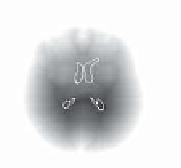Image Processing Reference
In-Depth Information
related to the caudate nucleus (information regarding the location and the approxi-
mate shape provided by the atlas, location in the brain and outside the lateral ventri-
cles, radiometry and relative position to the left of the lateral ventricles). The formal
definition of these representations can be found in [BLO 00b, BLO 00c].
The recognition of certain structures uses information about distance, which is
usually represented by fuzzy sets in the image space. Figure 9.8 illustrates this type of
representation for three types of knowledge.
μ
1
0
d
D
μ
1
0
d
D
μ
1
d
0
D
D
max
max
2
Figure 9.8.
Examples of the representation of knowledge about distances. Left: representation
in the form of fuzzy intervals in
R
+
. Right: the corresponding spatial representations.
The putamen is located at an approximately constant distance from the surface of the brain
(top), the caudate nucleus at a distance smaller than roughly
from the lateral ventricles
(represented in white) (middle), the lateral ventricles are in the brain at a distance greater
than roughly
D
from the surface of the brain (bottom). The contours of the objects
we are looking for (putamen, caudate nucleus and ventricles, respectively) are shown
in white and are in fact in the areas that satisfy the relations with a high degree
D
max
/
2
The fusion of spatial knowledge is achieved using a conjunctive operator (a t-
norm) in order to reduce the area of interest as new knowledge is provided, in order to
focus the search. Then these fused elements of spatial knowledge are combined to the
radiometric information by a mean operator, reaching this time a compromise between
these types of information. The resulting area can then be easily segmented (Figure
9.9).












































Search WWH ::

Custom Search